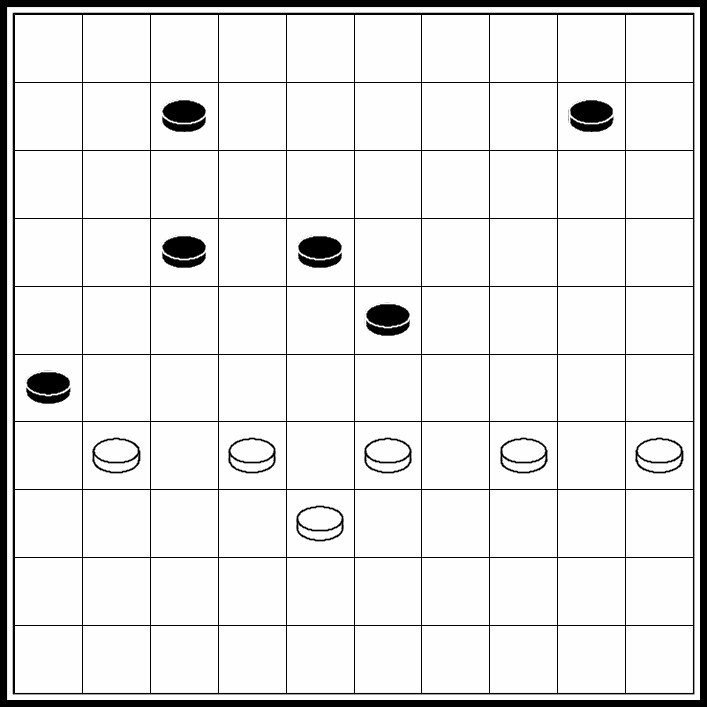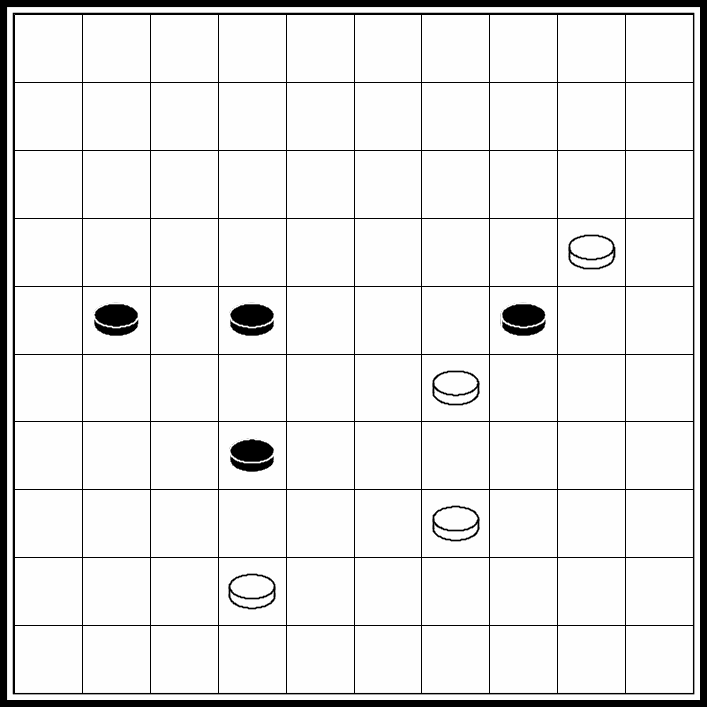
- •A course in international draughts
- •Sources
- •Introduction
- •About the author
- •Thank you!
- •Notation
- •2. Combinations
- •3. Coup Philippe
- •4. Harlem shot
- •5. Coup Royal
- •The Olympic formation.
- •6. Kung Fu shot
- •7. Ping Pong shot
- •8. Bomb shot
- •9. Arch shot
- •Grand prix shot
- •10. Coup Napoleon
- •Rabatel – Drost
- •Lesson 1: Notation
- •Lesson 2: Combinations
- •Lesson 3. Coup Phlippe
- •Lesson 4: Harlem shot
- •Lesson 5: Coup Royal
- •Lesson 6: Kung Fu shot
- •Lesson 7: Ping Pong shot
- •Lesson 8: Bomb shot
- •Lesson 9: Arch shot
- •Lesson 10: Coup Napoleon
- •11. More shots
- •Coup Springer
- •Coup Weiss
- •Coup Turc
- •12. Forcing
- •13. The free move
- •14. The stick move
- •Especially in case the enemy king attacks several pieces.
- •15. Giving your opponent a king
- •16. Attacking a wing
- •Isjimbaev – Tsjizjow
- •17. The sacrifice
- •Dussaut – De Heer 1886
- •18. Strong threats
- •Hoogland - Molimard
- •Thijssen – Tsjizjow
- •19. Base pieces
- •Wiersma – Sijbrands
- •Valneris - Hezemans
- •20. Trapping your opponent
- •Solutions lessons 11 - 20
- •21. King shots
- •22. The king is caught
- •Gantwarg – h. Jansen
- •Sijbrands – Andreiko
- •23. Formations
- •24. Freezing out your opponent
- •Ricou - Bonnard
- •25. Tactical freeze out
- •Mensonidus – Baba Sy
- •Tsjizjow - Keisels
- •26. Exploiting a weak spot
- •27. Locks
- •Right wing lock
- •Chain lock
- •Fork lock
- •Gantwarg - Andreiko
- •Semi – Fork
- •Arrow lock
- •Arrow lock
- •Left wing lock
- •28. The fork lock
- •Sijbrands – Morsink
- •29. The chain - lock
- •Lewina - Wanders
- •30. Right wing lock
- •27.2 Right wing lock
- •31. Other locks
- •Gantwarg – Galkin
- •32. The endgame
- •White is dominant
- •Strategic draw
- •33. Opposition
- •34. King against pieces
- •35. The main diagonal
- •36. Trictrac lines
- •37. Quadrants
- •38. Laying an ambush
- •39. Tactics in the endgame
- •40. Practical endgames
- •G. Heerema – m. De Jong
- •Mironov – Tsjizjow
- •H. Meijer – w. Sjtsjogoljew
- •Baba Sy - Agafonow
- •C. Van Leeuwen – Sjtsjogoljew
- •H. Jansen – a. Abidin
- •W. Leijenaar – j. Oost
- •Solutions lessons 31 - 40
2. Combinations
A combination (or shot) is a sequence of moves in which your opponent has to take several pieces after which you take more pieces or get a king.

White gives all his pieces but one, taking a shot.
1.26 – 21 17 x 26
2.37 – 31 26 x 37
3.38 – 32 37 x 28
4.39 – 33 28 x 39
5.40 – 34 39 x 30
6.35 x 11

In this diagram you have to give away pieces in the right sequence. After 1.45 – 40? black takes 34 x 45.
1.42 – 38 33 x 42
2.43 - 39 34 x 43
3.45 – 40 35 x 44
4.50 x 28
☼ It often helps to ask yourself the question: Where do I want to get a black piece to make a shot?

White wants a black piece at 31!
White has to begin playing 49 – 43 because playing other moves, white has to take back after 35 x 44 by 49 x 40 after which he loses his turn!
1.49 – 43! 35 x 44
2.43 – 39 44 x 33
3.42 – 38 33 x 42
4.41 – 37 42 x 31
5.36 x 9

White wants black to go to 20 and bring piece 26 to square 30. Because black has to capture at the next move white has a free move.
1.33 – 28! 29 x 20
2.27 – 21 26 x 17
3.28 – 22 17 x 28
4.39 – 33 28 x 39
5.40 – 34 39 x 30
6.35 x 11
☼ When looking for a shot you always have to look at moves giving away pieces !
Exercise 2.1

Write down the combination for white!

White can sometimes take one or more pieces during a combination. In this case black has to capture again to make sure white can move again. White removes piece 13 so that he can take a shot to king.
1.34 – 30! 25 x 23
2.28 x 19 13 x 24
3.37 – 31 26 x 28
4.33 x 4

White gives away 3 pieces in order to take back 4 pieces himself.
1.33 – 29 24 x 22
2.32 – 28 choice
3.38 x 20
At the first move black has to take the most pieces. At the second move black can choose how to take one piece, but it doesn’t make a difference.
☼ The majority rule is very important when taking shots. You always have to take the most pieces!
Exercise 2.2

White to play can perform a combination. At the first move black has to take the most pieces.
Write down the combination!

White will bring a black piece at 34 by taking backwards 34 x 43.
1.33 – 29 23 x 32
2.29 – 23 19 x 28
3.39 – 33 28 x 39
4.34 x 43 25 x 34
5.43 – 39 34 x 43
6.49 x 18

At the second move white takes a piece, but black has to take again, so that the combination goes on.
1.33 – 28 26 x 37
2.28 x 19 37 x 28
3.19 – 14 10 x 19
4.38 – 33 28 x 30
5.34 x 2

During the combination white takes two pieces. Removing piece 23 gives white a 45 x 3 shot.
1.33 – 28! 16 x 27
2.28 x 30 25 x 43
3.38 x 49 27 x 38
4.49 – 43 38 x 40
5.45 x 3
Exercise 2.3

Write down the combination for white!

Sometimes it makes sense to look at the strangest move you can play! Black to move can get one or two pieces (of course he should take 2 if the situation doesn’t change). White however offers him three pieces!
1.42 – 38 32 x 23
2.20 x 16

1.29 – 24! 20 x 27
2.23 x 5
Exercise 2.4

Write down the combination for white!
C 2.1

C 2.2

C 2.3

C 2.4

C 2.5

C 2.6

C 2.7

C 2.8
